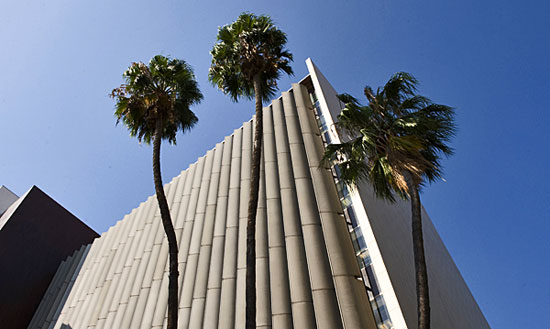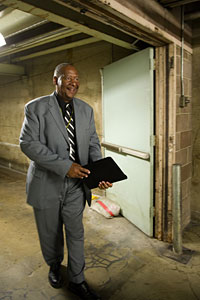
The Hall of Records is a mid-Century classic in the heart of downtown—but its upkeep is an ongoing challenge.
As the county Hall of Records hits the big 5-0 this year, it’s getting a youthful new neighbor and a second look by a public that’s been largely unaware of its towering architectural stature—and its aging condition.
Unbeknownst to many in the Civic Center crowd, the 1962 building is a striking example of Modernist architecture and ahead-of-its-time eco-design by the legendary Richard Neutra with his then-partner Robert Alexander.
Now that Grand Park, with its splashy pink furniture and high visibility quotient, is set to open its next segment right next door to the Hall of Records on September 11, a new generation of Angelenos is about to meet up with a structure that Los Angeles Times architecture critic Christopher Hawthorne describes as being “among the most underrated modernist buildings in Los Angeles.” There’s even talk of screening outdoor movies and concert simulcasts on the Hall of Records wall that faces the new Community Terrace section of the park.
“Bringing more people into the area is a good thing and will change how people view [the building],” said Linda Dishman, executive director of the Los Angeles Conservancy. Although she says the Hall of Records is “very much admired”—and eligible for listing on the California Register of historic resources—it’s less visible than other downtown Modernist favorities like architect A.C. Martin’s Department of Water and Power Building, not to mention Frank Gehry’s internationally acclaimed Walt Disney Concert Hall.
“Buildings that people can see from the freeway, they really tend to care about,” Dishman said.
Although it’s been keeping a low profile, the 15-story Hall of Records is a busy place, bustling with workers from eleven county departments. But its signature tenant, the Registrar-Recorder/County Clerk, picked up stakes and moved to Norwalk years ago, along with the records that gave the building its name.
And some signature elements of the building’s architecture are now broken, repurposed or out of public view, although many of its glories remain (see photo gallery below.)
Its most compelling features—massive solar-activated aluminum louvers, designed to move with the sun and keep the offices inside shaded—have been locked into place for more than two decades. The building’s manager says they’re “beyond economical repair.”
In a digital age, the windowless wing of the T-shaped building that was built to hold records now tends to hold mostly county workers instead.
A cafeteria on the building’s top floor, with its dramatic “spider leg” exterior columns and broad balcony showcasing killer views, has long since stopped dishing up lunch for bureaucrats. Instead, it’s been transformed into office space for Superior Court witness and juror services.
The Hall’s “Mad Men”-era lobbies have seen better days, too—though they still exude enough early ‘60s fabulousness to attract film and TV crews galore. (“The Lincoln Lawyer” shoot left behind spruced-up light fixtures and a series of oversized Los Angeles-themed photos in a glass case.)
And the exterior lighting that once illuminated the building’s Hill Street facade? It’s out of order, with a bench pulled over the fixtures so no one trips on them. “It’s on the list for repair,” sighs Charlie Bedell III, chief of the District Attorney’s Property Management Division. The D.A.’s office, which now occupies most of the office space in the Hall of Records, is charged with the often thankless task of maintaining the building. Other tenants range from the Alternate Public Defender and the Auditor-Controller to Regional Planning and the Treasurer-Tax Collector.
Still, there are signs that things are perking up: fresh landscaping around the building looks bright and healthy. A mosaic-and-granite mural by artist Joseph Young on the north side of the building was restored by a conservator hired by the county Arts Commission in 2008 (although it’s due for another cleaning soon.)
And, while the general public may be only vaguely aware of the Hall of Records’ existence, Hollywood location scouts have placed it on the A-list.
“Everybody wants to come to this building to film,” Bedell said. “They love the old architecture of this building. They love the uniqueness of this building.”
Hollywood also loves what’s not readily visible—the subterranean world of tunnels connecting the building with the Hall of Administration, the Hall of Justice and the Criminal Courts building.
“Most people don’t know these tunnels exist,” Bedell said, although they’ve been seen in features ranging from “Eagle Eye” to “National Treasure.”
With a long list of maintenance needs, and a short supply of funds, a top priority is repairing the tunnel doors so they can be secured after-hours—of particular importance now that a public underground parking lot serving Grand Park has opened right next to the Hall of Records.
But there’s so much left to do. The building’s deterioration frustrates Neutra’s son, architect Dion Neutra, who bemoans the non-functioning louvers, the “abandonment” of the rooftop cafeteria, the lobbies “all festooned with crap and signs.” His Vienna-born father worked for much of his career in Southern California, creating striking residences and office buildings that helped establish a signature mid-century aesthetic in Los Angeles, Orange County, Palm Springs and other areas. Some of Neutra’s buildings have been destroyed, and preserving his legacy requires vigilance. (Efforts to stop the planned demolition of Neutra’s Cyclorama Building at Gettysburg National Military Park in Pennsylvania are underway.)
In that context, the upkeep of the Hall of Records takes on new urgency, Dion Neutra said.
“Why would a steward of a building like that, with millions of dollars of original cost, allow it to deteriorate like that?” he asked. “It just doesn’t make sense.”
The significance of the building goes beyond its architectural pedigree. Integrated into the Hall of Records are two artworks from the county’s Civic Art collection: the Joseph Young mural and a dramatic eight-story-high screen by ceramicist Malcolm Leland that covers the building’s ventilation system.
Clare Haggerty, the Civic Art collections manager for the county Arts Commission, said she would like to see plaques installed on both artworks, to inspire passersby to take a deeper look at what’s in front of them. In the process, they might just see the Hall of Records itself in a whole new light.
“I would say that, like a lot of our artworks, sometimes to appreciate them, you need to know a little of their backstory,” Haggerty said. “It’s actually pretty amazing.”
Photos by Henry Salazar/Los Angeles County
Posted 8/28/12

















